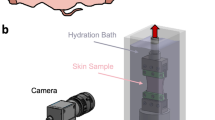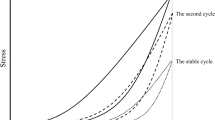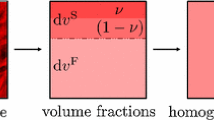Abstract
The analysis of tissue mechanics in biomedical applications demands nonlinear constitutive models able to capture the energy dissipation mechanisms, such as damage, that occur during tissue deformation. Furthermore, implementation of sophisticated material models in finite element models is essential to improve medical devices and diagnostic tools. Building on previous work toward microstructure-driven models of collagenous tissue, here we show a constitutive model based on fiber orientation and waviness distributions for skin that captures not only the anisotropic strain-stiffening response of this and other collagen-based tissues, but, additionally, accounts for tissue damage directly as a function of changes in the microstructure, in particular changes in the fiber waviness distribution. The implementation of this nonlinear constitutive model as a user subroutine in the popular finite element package Abaqus enables large-scale finite element simulations for biomedical applications. We showcase the performance of the model in fracture simulations during pure shear tests, as well as simulations of needle insertion into skin relevant to auto-injector design.













Similar content being viewed by others
Data and code sharing
The codes associated with this publication are available at https://github.com/abuganza/UMAT_anisotropic_damage under the GNU license.
References
Abaqus 6.14 Documentation
Afsar-Kazerooni N, Srinivasa A, Criscione J (2020) Experimental investigation of the inelastic response of pig and rat skin under uniaxial cyclic mechanical loading. Exp Mech 60(4):535–551
Alastrué V, Martinez M, Doblaré M, Menzel A (2009) Anisotropic micro-sphere-based finite elasticity applied to blood vessel modelling. J Mech Phys Solids 57(1):178–203
Azar T, Hayward V (2008) Estimation of the fracture toughness of soft tissue from needle insertion, In: International symposium on biomedical simulation, Springer, pp. 166–175
Bažant ZP, Jirásek M (2003) Nonlocal integral formulations of plasticity and damage: survey of progress, In: Perspectives in civil engineering: commemorating the 150th Anniversary of the American Society of Civil Engineers, ASCE, pp 21–52
Benítez JM, Montáns FJ (2017) The mechanical behavior of skin: Structures and models for the finite element analysis. Comput Struct 190:75–107
Bonet J, Wood RD (1997) Nonlinear continuum mechanics for finite element analysis. Cambridge University Press, Cambridge
Chen S, Annaidh AN, Roccabianca S (2020) A microstructurally inspired constitutive model for skin mechanics. Biomech Model Mechanobiol 19(1):275–289
Dal H, Açıkgöz K, Badienia Y (2021) On the performance of isotropic hyperelastic constitutive models for rubber-like materials: a state of the art review, Appl Mech Rev 73(2)
de Lucio M, Bures M, Ardekani AM, Vlachos PP, Gomez H (2021) Isogeometric analysis of subcutaneous injection of monoclonal antibodies. Comput Methods Appl Mech Eng 373:113550
Dou Z, Eshraghi J, Guo T, Veilleux J-C, Duffy KH, Shi GH, Collins DS, Ardekani AM, Vlachos PP (2020) Performance characterization of spring actuated autoinjector devices for emgality and aimovig. Curr Med Res Opin 36(8):1343–1354
Fehervary H, Maes L, Vastmans J, Kloosterman G, Famaey N (2020) How to implement user-defined fiber-reinforced hyperelastic materials in finite element software. J Mech Behav Biomed Mater 110:103737
Gasser TC (2011) An irreversible constitutive model for fibrous soft biological tissue: a 3-d microfiber approach with demonstrative application to abdominal aortic aneurysms. Acta Biomater 7(6):2457–2466
Gasser TC, Ogden RW, Holzapfel GA (2006) Hyperelastic modelling of arterial layers with distributed collagen fibre orientations. J R Soc Interface 3(6):15–35
Gundiah N, Ratcliffe MB, Pruitt LA (2009) The biomechanics of arterial elastin. J Mech Behav Biomed Mater 2(3):288–296
Han T, Lee T, Ledwon J, Vaca E, Turin S, Kearney A, Gosain AK, Tepole AB (2022) Bayesian calibration of a computational model of tissue expansion based on a porcine animal model. Acta Biomater 137:136–146
Holzapfel GA (2000) Nonlinear solid mechanics: a continuum approach for engineering. John Wiley and Sons, New York
Holzapfel GA, Ogden RW (2015) On the tension-compression switch in soft fibrous solids. European J Mech-A/Solids 49:561–569
Hou C, Ateshian GA (2016) A gauss-kronrod-trapezoidal integration scheme for modeling biological tissues with continuous fiber distributions. Comput Methods Biomech Biomed Engin 19(8):883–893
Hurschler C, Provenzano PP, Vanderby R Jr (2003) Application of a probabilistic microstructural model to determine reference length and toe-to-linear region transition in fibrous connective tissue. J Biomech Eng 125(3):415–422
Hurschler C, Loitz-Ramage B, Vanderby Jr R (1997) A structurally based stress-stretch relationship for tendon and ligament. ASME J Biomech Eng 119(4):392–399. https://doi.org/10.1115/1.2798284
Jor JWY, Nash MP, Nielsen PMF, Hunter PJ (2010) Estimating material parameters of a structurally based constitutive relation for skin mechanics. Biomech Model Mechanobiol 10(5):767–778
Kivitz A, Cohen S, Dowd JE, Edwards W, Thakker S, Wellborne FR, Renz CL, Segurado OG (2006) Clinical assessment of pain, tolerability, and preference of an autoinjection pen versus a prefilled syringe for patient self-administration of the fully human, monoclonal antibody adalimumab: The touch trial. Clin Ther 28(10):1619–1629
Koh CT, Tonsomboon K, Oyen ML (2019) Fracture toughness of human amniotic membranes. Interface Focus 9(5):20190012
Krueger R (2015) The virtual crack closure technique for modeling interlaminar failure and delamination in advanced composite materials, In: Numerical modelling of failure in advanced composite materials, Elsevier, pp 3–53
Kumaraswamy N, Khatam H, Reece GP, Fingeret MC, Markey MK, Ravi-Chandar K (2017) Mechanical response of human female breast skin under uniaxial stretching. J Mech Behav Biomed Mater 74:164–175
Lanir Y (1983) Constitutive equations for fibrous connective tissues. J Biomech 16(1):1–12
Lee S, Pharr M (2019) Sideways and stable crack propagation in a silicone elastomer. Proc Natl Acad Sci 116(19):9251–9256
Lee T, Vaca EE, Ledwon JK, Bae H, Topczewska JM, Turin SY, Kuhl E, Gosain AK, Tepole AB (2018) Improving tissue expansion protocols through computational modeling. J Mech Behav Biomed Mater 82:224–234
Lee T, Turin SY, Gosain AK, Bilionis I, Buganza Tepole A (2018) Propagation of material behavior uncertainty in a nonlinear finite element model of reconstructive surgery. Biomech Model Mechanobiol 17(6):1857–1873
Leng Y, de Lucio M, Gomez H (2021) Using poro-elasticity to model the large deformation of tissue during subcutaneous injection. Comput Methods Appl Mech Eng 384:113919
Li W, Luo XY (2016) An invariant-based damage model for human and animal skins. Ann Biomed Eng 44(10):3109–3122
Limbert G (2017) Mathematical and computational modelling of skin biophysics: a review. Proc Royal Soc A Math Phys Eng Sci 473(2203):20170257
Liu H, Sun W (2015) Computational efficiency of numerical approximations of tangent moduli for finite element implementation of a fiber-reinforced hyperelastic material model. Comput Methods Biomech Biomed Engin 19(11):1171–1180
Long R, Hui C-Y (2016) Fracture toughness of hydrogels: measurement and interpretation. Soft Matter 12(39):8069–8086
Meador WD, Sugerman GP, Story HM, Seifert AW, Bersi MR, Tepole AB, Rausch MK (2020) The regional-dependent biaxial behavior of young and aged mouse skin: A detailed histomechanical characterization, residual strain analysis, and constitutive model. Acta Biomater 101:403–413
Mullins L (1948) Effect of stretching on the properties of rubber. Rubber Chem Technol 21(2):281–300
Ogden RW, Roxburgh DG (1999) A pseudo–elastic model for the mullins effect in filled rubber, In: Proceedings of the royal society of London. Series A: Mathematical, Physical and Engineering Sciences vol 455(1998) (1999) pp 2861–2877
Park K, Paulino GH (2011) Cohesive zone models: A critical review of traction-separation relationships across fracture surfaces, Appl Mech Rev 64(6)
Pierce DM, Unterberger MJ, Trobin W, Ricken T, Holzapfel GA (2016) A microstructurally based continuum model of cartilage viscoelasticity and permeability incorporating measured statistical fiber orientations. Biomech Model Mechanobiol 15(1):229–244
Pond D, McBride A, Davids L, Reddy B, Limbert G (2018) Microstructurally-based constitutive modelling of the skin - linking intrinsic ageing to microstructural parameters. J Theor Biol 444:108–123
Prot V, Skallerud B (2009) Nonlinear solid finite element analysis of mitral valves with heterogeneous leaflet layers. Comput Mech 43(3):353–368
Purslow P (1983) Measurement of the fracture toughness of extensible connective tissues. J Mater Sci 18(12):3591–3598
Rausch MK, Humphrey JD (2016) A microstructurally inspired damage model for early venous thrombus. J Mech Behav Biomed Mater 55:12–20
Rausch M, Meador WD, Toaquiza-Tubon J, Moreno-Flores O, Tepole AB (2022) Biaxial mechanics of thermally denaturing skin - part 2: Modeling. Acta Biomater 140:421–433. https://doi.org/10.1016/j.actbio.2021.11.031
Rivlin RS, Thomas AG (1953) Rupture of rubber. i. characteristic energy for tearing. J Polymer Sci 10(3):291–318
Sachs D, Wahlsten A, Kozerke S, Restivo G, Mazza E (2021) A biphasic multilayer computational model of human skin. Biomech Model Mechanobiol 20(3):969–982
Shergold OA, Fleck NA (2004) Mechanisms of deep penetration of soft solids, with application to the injection and wounding of skin. Proc Royal Soc London Series A: Math Phys Eng Sci 460(2050):3037–3058
Simo J (1987) On a fully three-dimensional finite-strain viscoelastic damage model: Formulation and computational aspects. Comput Methods Appl Mech Eng 60(2):153–173
Simo JC, Ju J (1987) Strain-and stress-based continuum damage models-i. formulation. Int J Solids Struct 23(7):821–840
Simo J, Ju J (1987) Strain-and stress-based continuum damage models-ii computational aspects. Int J Solids Struct 23(7):841–869
Sree VD, Ardekani A, Vlachos P, Tepole AB (2022) The biomechanics of autoinjector-skin interactions during dynamic needle insertion. J Biomech 134:110995
Tac V, Costabal FS, Tepole AB (2022) Data-driven tissue mechanics with polyconvex neural ordinary differential equations.. Comput Methods Appl Mech Eng 398:115248. https://doi.org/10.1016/j.cma.2022.115248
Tonge TK, Atlan LS, Voo LM, Nguyen TD (2013) Full-field bulge test for planar anisotropic tissues: Part i - experimental methods applied to human skin tissue. Acta Biomater 9(4):5913–5925
Tonge TK, Voo LM, Nguyen TD (2013) Full-field bulge test for planar anisotropic tissues: Part ii - a thin shell method for determining material parameters and comparison of two distributed fiber modeling approaches. Acta Biomater 9(4):5926–5942
Waffenschmidt T, Polindara C, Menzel A, Blanco S (2014) A gradient-enhanced large-deformation continuum damage model for fibre-reinforced materials. Comput Methods Appl Mech Eng 268:801–842
Wang S, Hatami-Marbini H (2020) Constitutive modeling of corneal tissue: Influence of three-dimensional collagen fiber microstructure, J Biomech Eng 143(3)
Weickenmeier J, Jabareen M, Mazza E (2015) Suction based mechanical characterization of superficial facial soft tissues. J Biomech 48(16):4279–4286
Zhang T, Lin S, Yuk H, Zhao X (2015) Predicting fracture energies and crack-tip fields of soft tough materials. Extreme Mech Lett 4:1–8
Acknowledgements
This work was supported by a Grant from Eli Lilly and company.
Author information
Authors and Affiliations
Corresponding author
Additional information
Publisher's Note
Springer Nature remains neutral with regard to jurisdictional claims in published maps and institutional affiliations.
Rights and permissions
Springer Nature or its licensor holds exclusive rights to this article under a publishing agreement with the author(s) or other rightsholder(s); author self-archiving of the accepted manuscript version of this article is solely governed by the terms of such publishing agreement and applicable law.
About this article
Cite this article
Toaquiza Tubon, J.D., Moreno-Flores, O., Sree, V.D. et al. Anisotropic damage model for collagenous tissues and its application to model fracture and needle insertion mechanics. Biomech Model Mechanobiol 21, 1–16 (2022). https://doi.org/10.1007/s10237-022-01624-y
Received:
Accepted:
Published:
Issue Date:
DOI: https://doi.org/10.1007/s10237-022-01624-y




